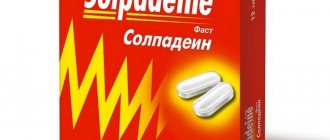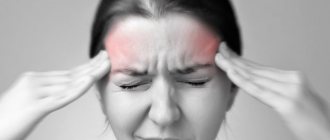What Can Cause Tension Headaches?
The true reasons for the development of tension-type headache have not yet been clarified, but doctors have identified two provoking factors.
Mental stress
We are talking about a chronic stressful condition, which is accompanied by severe muscle tension. During such tension, compression of the blood vessels located in the thickness of the muscles occurs, which leads to disruption of metabolic processes. It is precisely this “mechanism” of development of the problem that provokes a severe headache - this is a signal that something needs to be done to prevent the development of serious pathologies of a neurological nature. In this case, you need to remove the stress factor.
Incorrect ratio of pain and anti-pain impulses
This problem occurs with frequent anxiety, anxiety, and depression, which cause disturbances in the functioning of mediators. This situation ends with a decrease in the threshold of pain perception, and the person experiences severe headaches from any even minor touch.
Doctors do not separate these two provoking factors, since they are always interrelated. The described condition in almost every case is associated with hypochondria, neuroses and asthenia.
Causes
From the name of the syndrome it is clear that it is associated with muscle overstrain. The occurrence of a headache is preceded by the following symptoms - fatigue and spasm of the muscles of the face, eyes, scalp, back and neck. Because of this, the blood supply to the muscles and brain is disrupted, which leads to pain.
The following reasons lead to this condition:
- constant lack of sleep;
- acute or chronic stress (the help of a psychologist will help you get rid of it);
- malnutrition and debilitating diets;
- work in a stuffy room and in the heat;
- long stay in an uncomfortable position;
- severe eye strain;
- emotional disorders (depression);
- anxiety and somatoform disorder.
Regular exposure to unfavorable factors (chronic stress, difficult working conditions) leads to the development of permanent tension-type headache. In the case of a single stressful situation or overexertion, episodic tension-type headache often develops.
How does HDN manifest?
The symptoms of the disease in question are quite characteristic and can form the basis for making a preliminary diagnosis. The patient will complain of constantly present dull sensations of pressure in the muscles of the neck, temporal muscles, and scalp muscles. They are often described as looking like they are wearing a hoop, hard hat or helmet on their head. Characteristics of pain with TTH:
- Most often, bilateral localization of unpleasant sensations is recorded, sometimes it is unilateral;
- may have a clearly circumscribed location, but is often described as “spill over”;
- the pain becomes more intense with any touch, shock, going down stairs, moving the head, and even blowing wind.
Please note: tension headaches may be accompanied by sensitivity to light and sound. Nausea and vomiting are not typical for HDN.
Based on how often symptoms appear, TTH is divided into two types.
- Episodic pain. Appears up to 15 times a month, each attack lasts no more than 30 minutes, and can occur during physical activity.
- Chronic pain. The frequency of attacks is more than 15 times a month, and the total duration is 3 months.
The episodic form of the disease always becomes chronic if the person has not received any treatment.
At CELT you can get advice from a neurologist.
- Initial consultation – 4,000
- Repeated consultation – 2,500
Make an appointment
Most people experience episodes of tension-type headache from time to time, with women experiencing it more often than men; TTH can also occur in childhood.
The mechanisms of the occurrence and development of tension headaches are not fully understood. Previously, the development of tension-type headache was associated with spasm of the muscles of the head and neck. It was assumed that due to the compression of the vessels of the spasmodic muscles of the head and neck, blood circulation in them is reduced, which leads to pain.
Today it has been established that prolonged psycho-emotional stress, anxiety, and depression play a leading role in the development of tension-type headache. Patients with chronic tension headaches tend to have low cortisol levels, which may be a consequence of chronic stress.
There are two main factors for HDN:
- Emotional stress: increased anxiety, stress, sleep disturbance.
- Physical tension in the muscles of the scalp and neck, which may be caused by working in an uncomfortable position, sitting for a long time at the computer, poor posture when lifting weights, and similar loads.
Symptoms
- The pain is almost always bilateral and feels like a painful “hoop” or “helmet”.
- Often localized in the temples, forehead, and back of the head.
- The character is squeezing or pressing.
- Sometimes it can be combined with loss of appetite, rarely with mild nausea or vomiting, photophobia or sound sensitivity.
- Does not increase due to physical activity.
- Often patients complain of a feeling of heaviness or pressure, rather than pain.
- Palpation can reveal soreness in the muscles of the head and neck, especially the muscles of the temporal and occipital region.
There are two types of tension headaches.
- Episodic headache (from 1 to 14 days with headache per month). This type of headache is usually associated with a stressful event, is of moderate intensity, and usually ends on its own or is easily relieved with standard analgesics.
- Chronic headache (more than 15 days with headache per month) is often associated with chronic psycho-emotional stress, anxiety and depression, and increased tension in the muscles of the neck and head. This type is often manifested by monotonous squeezing, pressing pain, usually with fronto-occipital localization.
The transition from one form to another may be due to a combination of tension-type headache with migraine, depression and anxiety-panic disorders, severe myofascial syndrome, pathology of the temporomandibular joint, and sleep disorders.
The duration of an episode of tension headache can be from 30 minutes to seven days, in the absence of pain relief therapy.
Diagnostic methods
As a rule, a patient with a headache consults a neurologist. At the first appointment with a doctor, the patient must answer a number of questions - how often does a headache occur, what can it be associated with, what time of day does it occur, where is it localized. Then a life history will be collected - the doctor will find out what diseases were previously diagnosed, whether head injuries have occurred recently, and so on.
Often such a full-fledged survey is enough to make a diagnosis, but in order to prevent mistakes, specialists prescribe an instrumental examination, often a computed tomography of the brain. If there are no morphological pathological changes in the structure of the brain, blood pressure levels are within normal limits, and no other reasons for the occurrence of the condition in question have been identified, then the diagnosis is considered complete.
Our doctors
Pankov Alexander Rostislavovich
Neurologist
40 years of experience
Make an appointment
Novikova Larisa Vaganovna
Neuropathologist, Candidate of Medical Sciences, doctor of the highest category
Experience 39 years
Make an appointment
Treatment for tension headaches
This type of headache requires the use of certain medications. If the type of tension headache in question occurs infrequently, then a single dose of non-steroidal/anti-inflammatory drugs will help. With frequent repetitions of episodic TTH, doctors suggest that the patient take a course of the same medications in order to “break” the cycle of repetitions.
Please note: if after the first course of the described therapy there is no relief, then repeating the treatment is not advisable.
Acupuncture
- Cost: 3,000 rub.
- Duration: up to 20 minutes
More details
Often, TTH is accompanied by spasm of the pericranial muscles (muscles of the back of the neck, masticatory, temporal, scalp muscles), which worsens the patient’s well-being and intensifies the main symptom. To get rid of this unpleasant feeling, it is recommended to take muscle relaxants. Also for this purpose, injections of local anesthetics (lidocaine, naropin) are performed into spasmodic muscles.
People with pronounced symptoms most often do not seek qualified medical help, but try to solve the problem on their own by taking painkillers. This will not solve the problem - treatment of tension-type headache requires an integrated approach. As an additional therapy, a specialist may prescribe vitamins, nootropic or sedatives.
Additional treatment methods play an important role in successful therapy:
- acupuncture;
- massage;
- auto-training and psychotherapist assistance;
- physiotherapy (electrosleep, electrophoresis on the cervical spine with various drugs).
Types of headaches
There are several types of headaches with VSD:
- physical stress;
- post-stress, resulting from excessive mental and physical stress; physical stress;
- morning, which is based on congestive disturbances of blood flow in the brain;
- pain caused by oxygen starvation, which appeared while being in a stuffy room.
Most often, with VSD there are 2 types of headaches - tension and migraine. Despite the fact that such a condition is always subjective, it is still possible to describe individual symptoms.
Treatment of chronic tension headache
If a tension headache occurs in a chronic form, then it is forbidden to take classical drugs with an analgesic effect! Not only will they not relieve pain, but they will also complicate the process of full treatment. Doctors prescribe antidepressants, which must be taken for six months according to a specially developed individual regimen. It is also possible to prescribe other medications from the group of antidepressants; the course of therapy is at least 60 days.
This treatment tactic involves not only getting rid of pain, but also eliminating the cause of tension headaches - for example, antidepressants solve the problem of dysfunction of the autonomic nervous system. Physiotherapeutic procedures (the same as in the case of therapy for episodic pathology) will also have an additional therapeutic effect.
Tension headaches require a professional approach to treatment. If symptoms of this disease appear, it is advisable to contact specialists at CELT - all necessary diagnostic measures will be carried out and treatment will be prescribed.
Make an appointment through the application or by calling +7 +7 We work every day:
- Monday—Friday: 8.00—20.00
- Saturday: 8.00–18.00
- Sunday is a day off
The nearest metro and MCC stations to the clinic:
- Highway of Enthusiasts or Perovo
- Partisan
- Enthusiast Highway
Driving directions
Treatment
Therapeutic assistance for tension-type headache is selected individually. There are no universal medications or therapies specifically for tension headaches. The main goals of treatment: normalization of the emotional state, correction of the mental state, restoration of normal muscle tone, alignment of the sleep-wake cycle, formation of a healthy lifestyle.
Methods of therapy for tension-type headache:
- Pharmacotherapy: antidepressants, nootropics, neurometabolic therapy, restoratives, muscle relaxants, etc.
- Psychotherapy: cognitive therapy, relaxation training, hypnosis and trance states.
- Biofeedback therapy.
- Physiotherapy: electrosleep, electroanalgesia.
- Diet therapy.
- Massage, manual therapy, physical therapy.
After the result is achieved and the pain has gone, you should follow the doctor’s advice on the prevention of tension-type headache: strengthen mental and physical health, maintain a daily routine and exercise routine, conduct a medical examination (identify diseases in the early, initial stages).









